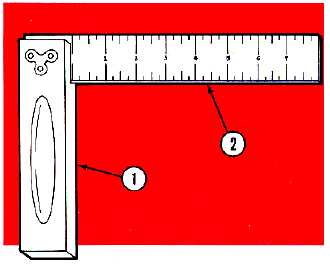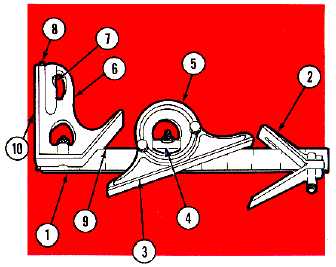TM 9-243
TYPES AND USES - Continued
The following scales or inch divisions are found on the
carpenter's square:
Face of body
outside edge
inches and sixteenths
Face of body
inside edge
inches and eighths
Face of tongue
outside edge
inches and sixteenths
Face of tongue
inside edge
inches and eighths
Back of body
outside edge
inches and twelfths
Back of body
inside edge
inches and sixteenths
Back of tongue
outside edge
inches and twelfths
Back of tongue
inside edge
inches and tenths
TRY SQUARE
The try square is made of a steel or wood stock (1) and
a blade (2). The blade is from 2 to 12 inches long and is
graduated in eighths. The try square is used to set or
check lines which are at right angles (90 degrees) to
each other.
COMBINATION SQUARE
The combination square is made up of the following
components:
1.
A slotted 12-inch stainless steel rule (1) which is
graduated in eighths, sixteenths, thirty-seconds,
and sixty-fourths of an inch. It can be used as a
measuring scale by itself or with any one of the
following components.
2.
The center head (2), when attached to the rule,
bisects a 90 degree angle. It's used for
determining the center of cylindrical work.
3.
The protractor (3) has a level (4) and a
revolving turret (5) which is graduated in
degrees from 0 to 180 or 0 to 90 in either
direction. It is used to lay out and measure
angles to within one degree.
4.
The square head (6) has a level (7), a scribe (8),
and 45 degree (9) and 90 degree sides (10). It
is used to lay out 45 and 90 degree angles and
to check level. It may also be used as a height
or depth gage.
13-3



